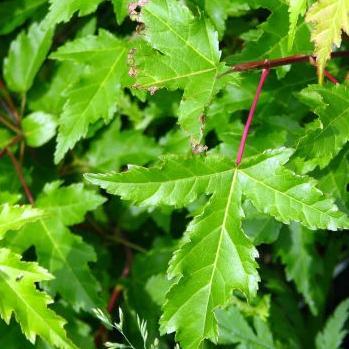Flame Amur Maple
Acer ginnala 'Flame'
- En stock
- Pedido pendiente, envío pronto
- Cultivados localmente
- Garantizado Manejado con cuidado
The Flame Amur Maple, also known by its scientific name Acer ginnala 'Flame', is a deciduous tree native to northeastern Asia. It's known for its vibrant fall color and adaptability to various growing conditions.
Here are some key features of the Flame Amur Maple:
-
Foliage: The leaves are small and three-lobed, turning from green in the summer to brilliant shades of red and orange in the fall, hence the name "Flame".
-
Size: This tree typically grows to a height of 15-20 feet and spreads 15-20 feet wide, making it a smaller maple variety.
Prefers full sun in cooler climates, but prefers afternoon shade in southern areas.
The Flame Amur Maple is often used as a street or shade tree due to its moderate size and tolerance of urban conditions. It's also popular for its vibrant fall color, which can add a splash of brightness to any landscape.
|
Type: |
Tree |
|
Origins: |
East Asia |
|
Height: |
15’ - 20’ |
|
Spread: |
15’ - 20’ |
|
Spacing: |
18’ |
|
USDA Hardiness Zone: |
2 - 8 |
|
Culture: |
Full Sun, Part Sun |
|
Bloom Color: |
Yellow |
|
Season of Interest: |
Fall |
MAINTENANCE NEEDS: : Low maintenance. Water regularly. Potential diseases include verticillium wilt, stem canker, leaf spots, tar spot, and anthracnose. Watch for aphids, borers, scale, leafhoppers, caterpillars, and mites.
LANDSCAPE USES: Group Plantings or Specimen Tree, Woodland Gardens, Privacy Screen, Street Tree, and Shade Tree
COMPANION PLANTS: Viburnum, Cotoneaster, Coral Bells
IMAGE:: Photos by UMI Extension, Amur Maple
*As plants have ranges in appearance they may not appear as the images shown.
¡¡¡Aprovecha Un Servicio De Entrega Con El Que Puedes Contar!!! Ofrecemos una amplia variedad de camiones para sus necesidades de entrega. Servicio de entrega puntual y sin complicaciones, cuando lo necesite y donde lo necesite. ¡Ya sea en su jardín o directamente en el lugar de trabajo!
Las áreas de envío locales incluyen todo Maryland, Virginia del Norte, Pensilvania y Washington DC; también se pueden organizar áreas que no figuran en la lista.








